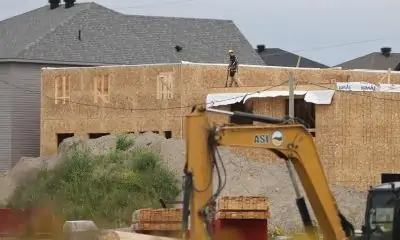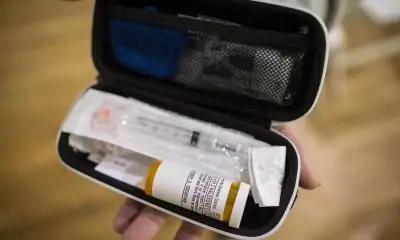It’s a dinosaur that roamed Alberta’s badlands more than 70 million years ago, sporting a big, bumpy, bony head the size of a baby elephant.
On Wednesday, paleontologists near Grande Prairie pulled its 272-kilogram skull from the ground.
They call it “Big Sam.”
The adult Pachyrhinosaurus is the second plant-eating dinosaur to be unearthed from a dense bonebed belonging to a herd that died together on the edge of a valley that now sits 450 kilometres northwest of Edmonton.
It didn’t die alone.
“We have hundreds of juvenile bones in the bonebed, so we know that there are many babies and some adults among all of the big adults,” Emily Bamforth, a paleontologist with the nearby Philip J. Currie Dinosaur Museum, said in an interview on the way to the dig site.
She described the horned Pachyrhinosaurus as “the smaller, older cousin of the triceratops.”
“This species of dinosaur is endemic to the Grand Prairie area, so it’s found here and nowhere else in the world. They are … kind of about the size of an Indian elephant and a rhino,” she added.
The head alone, she said, is about the size of a baby elephant.
The discovery was a long time coming.
The bonebed was first discovered by a high school teacher out for a walk about 50 years ago. It took the teacher a decade to get anyone from southern Alberta to come to take a look.
“At the time, sort of in the ’70s and ’80s, paleontology in northern Alberta was virtually unknown,” said Bamforth.
When paleontogists eventually got to the site, Bamforth said, they learned “it’s actually one of the densest dinosaur bonebeds in North America.”
“It contains about 100 to 300 bones per square metre,” she said.
Paleontologists have been at the site sporadically ever since, combing through bones belonging to turtles, dinosaurs and lizards. Sixteen years ago, they discovered a large skull of an approximately 30-year-old Pachyrhinosaurus, which is now at the museum.
About a year ago, they found the second adult: Big Sam.
Bamforth said both dinosaurs are believed to have been the elders in the herd.
“Their distinguishing feature is that, instead of having a horn on their nose like a triceratops, they had this big, bony bump called a boss. And they have big, bony bumps over their eyes as well,” she said.
“It makes them look a little strange. It’s the one dinosaur that if you find it, it’s the only possible thing it can be.”
The genders of the two adults are unknown.
Bamforth said the extraction was difficult because Big Sam was intertwined in a cluster of about 300 other bones.
The skull was found upside down, “as if the animal was lying on its back,” but was well preserved, she said.
She said the excavation process involved putting plaster on the skull and wooden planks around if for stability. From there, it was lifted out — very carefully — with a crane, and was to be shipped on a trolley to the museum for study.
“I have extracted skulls in the past. This is probably the biggest one I’ve ever done though,” said Bamforth.
“It’s pretty exciting.”
This report by The Canadian Press was first published Sept. 25, 2024.
























